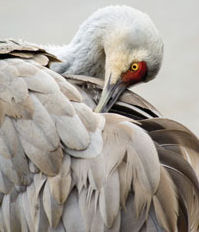 On a map, the irregularly shaped dot of Westham Island, just south of Vancouver, British Columbia, seems somewhat small and insignificant. For migrating birds and numerous species of mammal, however, it is anything but. Situated near the island's tip is the George C. Reifel Migratory Bird Sanctuary. Small though it may be, the 850 acres of open fields, tidal flats, marshes and creeks attracts thousands of birds and is home to many mammals. A visit to this sanctuary makes an excellent day trip during the winter months.
On a map, the irregularly shaped dot of Westham Island, just south of Vancouver, British Columbia, seems somewhat small and insignificant. For migrating birds and numerous species of mammal, however, it is anything but. Situated near the island's tip is the George C. Reifel Migratory Bird Sanctuary. Small though it may be, the 850 acres of open fields, tidal flats, marshes and creeks attracts thousands of birds and is home to many mammals. A visit to this sanctuary makes an excellent day trip during the winter months.
Why should your family take this field trip? For one, it offers you better views of wintering snow geese than you might see in Skagit County. Instead of parking on the side of a busy road, viewing platforms and an observation tower make it easy and safe to watch these spectacular birds as they rest, feed and fly. And the counts are huge, ranging from 30,000 to 80,000 birds each year.
Snow geese are not the only reason to visit this place. You can see many birds and mammals along the refuge pathways. Just a few steps past the bungalow-style gatehouse and gift shop, dozens of mallards, Canada geese, wigeons and other ducks congregate along the walkways, scurrying, quacking, begging for a toss of birdseed. (You can buy birdseed for 50 cents a bag at the entrance.) Adult or child, if you walk, they will follow. Across Fuller's Slough, you can make out the faint shapes of black-crowned night-herons sleeping in bordering brambles. Along the pond edge, you might see sandhill cranes preening and resting. Northern saw-whet owls roost in low-hanging boughs. Step into the warming hut, which overlooks the pond and is a wonderful respite from the cold. Its oversized tables, picture windows and wood-burning stove make it the perfect place for a brown-bag lunch.
Several trails converge at this point. Due north is the perimeter trail. Other trails angle towards the center of the refuge, eventually linking with the perimeter trail. A map available at the entrance shows trails, viewing platforms, blinds and the observation tower. A well-thumbed book posted outside of the warming hut tells you where to look for recent sightings.
For first-timers and children, the perimeter trail is best. Children can lead the way. Douglas firs, western red cedars, red alders, brambles, grasses, pearly everlasting and cattails offer ample food and refuge to songbirds, owls, woodpeckers, pheasants, raccoons and weasels. A murky slough parallels this trail, harboring ducks, great blue herons and American bitterns. Walk slowly and look for songbirds such as black-capped and chestnut-backed chickadees, ruby-crowned kinglets, fox sparrows, savannah sparrows, spotted towhees and dark-eyed juncos darting through the brush. The chickadees are tame. Fill your hand with birdseed, extend it and hold very still. They will perch on and feed from your hand — a thrill for anyone.
Each bend of this trail turns up something new. A hairy woodpecker drills for bugs. A family of raccoons lumbers cautiously among the cattails. A weasel moves at lightning speed across the trail. If you see one, keep watching. Curious by nature, this tiny, wheat-colored mammal will pop its head back out to peek at you. Mink, beavers and muskrats live in the refuge, as well.
Eventually you will end up at the observation tower. Climb the tower's two stories to see expansive views of the refuge, shorebirds, swans and snow geese. To those of us who visit often, the spectacular sight and sound of snow geese flocks landing or taking off is never repetitious. Moving as one, their white feathers streak the sky. Their calls create a disharmonic song.
The island seems a century away from the modern, traffic-laden city of Vancouver. Linked to the mainland by a one-lane wooden bridge, the landscape is distinctively rural. Early 1900s-era dikes and reclamation projects are still evident. Farming is the main occupation, and homes are scarce.
Originally, George C. Reifel owned the land as a recreational retreat. Conservationists Barry Leach and Fred Auger recognized the importance of the tiny island and in 1961, they leased the land from the Reifels and began establishing the area as a waterfowl sanctuary. The Reifels gave the sanctuary land to the government in 1973 and sold it an additional 600 acres of back-up land. Today, the British Columbia Waterfowl Society manages the refuge under a long-term lease from the government.
As you wander back to the entrance, make note of the refuge's goal: to provide wetland habitat and to teach others that the Fraser estuary is essential to the survival of migratory birds. Has it succeeded? I think it has. You and your family will leave knowing this tiny area's importance. Without it, the birds may perish.
Rebecca Bailey is a freelance writer specializing in nature and wildlife. She lives in Everett and has two children.
Brothers Curt and Cary Given of Given Photography have more than two decades of experience in nature, wildlife and landscape photography. Their comprehensive collection of bird photos includes more than 400 species found in North and Central America.
Go
From the U.S.-Canada border, take Highway 99 north to Ladner Trunk Road. Drive west on Ladner to River Road. Turn right, following River Road to the Westham Island Bridge. Cross the bridge and follow the main road to the Reifel Bird Sanctuary entrance. The sanctuary is located about 30 minutes from the border.
It is a good idea to bring binoculars and cameras. Field guides are helpful if you have them, but not necessary. Dress for the weather and wear comfortable walking shoes.
Admission is C$5 for adults and C$3 for children and seniors. Hours are 9 a.m. to 4 p.m.
Web site: www.reifelbirdsanctuary.com
For the latest information about traveling into Canada visit http://travel.state.gov and click on “Travel to Canada, Mexico and the Caribbean.” New rules, which require photo ID and a birth certificate when traveling in and out of the United States, go into effect Jan. 31, 2008. For border wait times, visit www.wsdot.wa.gov/traffic/border/.
Along the way
Although it takes approximately two and a half hours to drive to the sanctuary from Seattle, it is a feasible day trip. Children will be excited about the idea of traveling to another country, and stops along the way make it a full day of family fun.
Eat: If you are hungry, plan to stop at Fairhaven — a beautifully preserved historic neighborhood of cafes and bookstores in Bellingham. It's a short drive from the freeway and its one-of-a-kind restaurants make this a good place for breakfast or lunch.
Stretch: Get some exercise while wandering through The Peace Arch Park, located by the border in Blaine, Wash. This 20-acre park features the giant commemorative, concrete arch that straddles the U.S.-Canada border. Look for horticulture and interpretation displays here, too.
If you stay
Delta Town & Country Inn is located about 15 minutes from the sanctuary and is at the Ladner Trunk Road freeway exit. Winter rates start at C$95. 6005 Highway 17, Delta, B.C., 1-888-777-1266, www.deltainn.com. For more options, visit www.deltachamber.com.
This article was originally published in the December 2007 issue of ParentMap.









